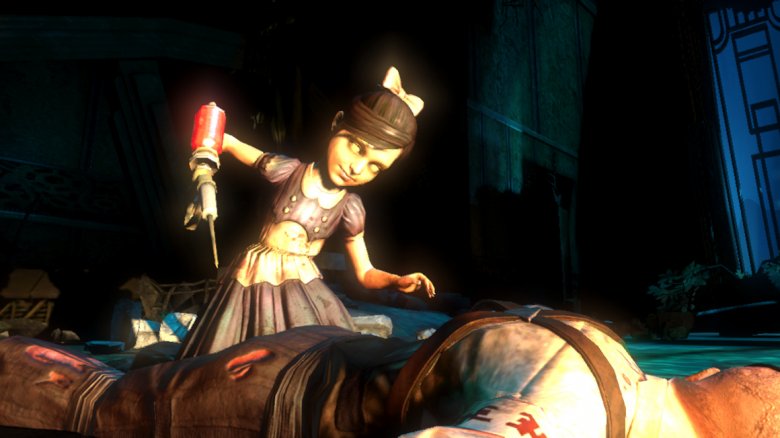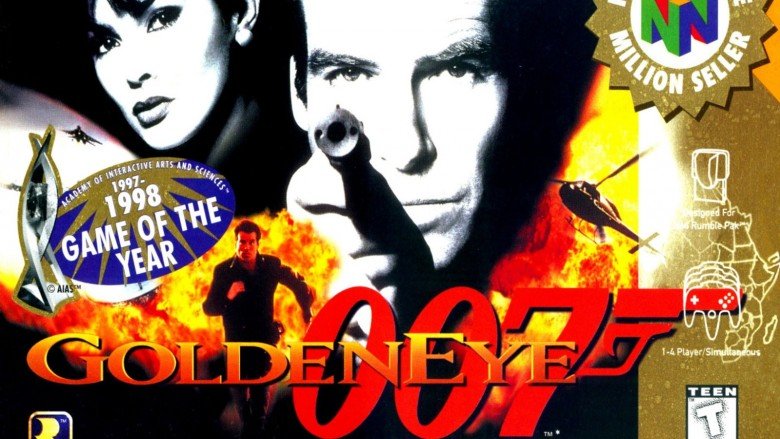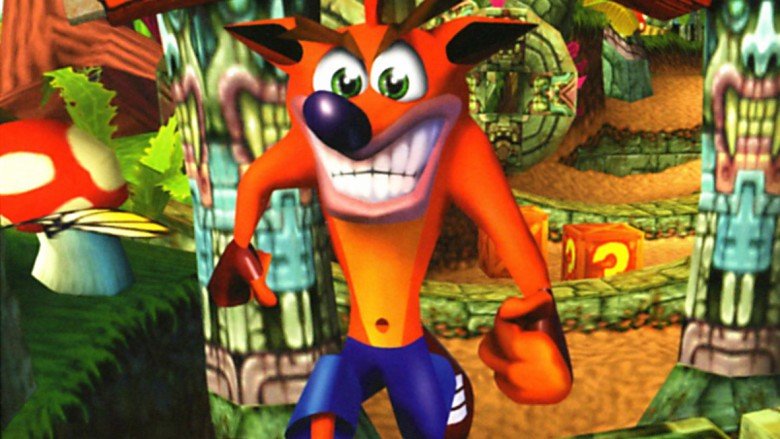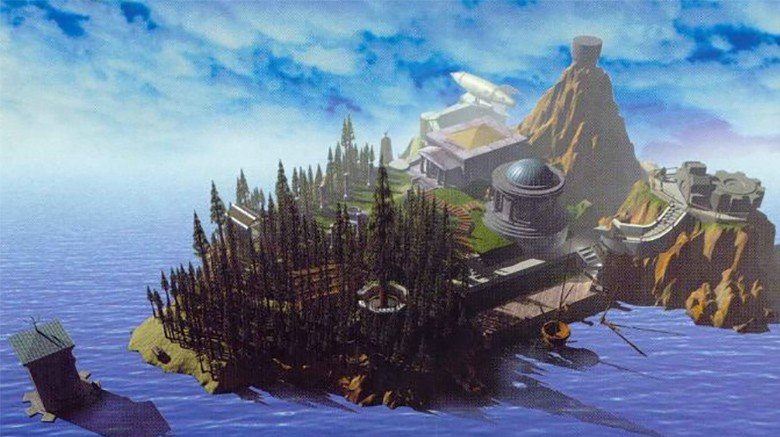Great Video Games That Have Aged Terribly
In a world filled with multi-hour install times, crucial features distributed via premium downloadable content, multiplayer matches infested with trolls, endless sequels, busted launches, microtransactions, and mandatory patch downloads, people keep asking one question: why aren't video games be as fun as they used to be?
Spoiler alert: they are. Sure, that old Nintendo 64 shooter, PlayStation platformer, and PC strategy game might've been a big deal back in the day, but nostalgia is a powerful drug, and none of them are quite as good as you remember. Trust us. You can't go back again, and it's better to leave well enough alone than to sully your happy memories by revisiting these classic titles:
Goldeneye 007
Don't replay GoldenEye. Just, don't. Yes, GoldenEye is the first console-based first person shooter to really catch on with the public. Yes, it's full of once-innovative features like stealth-based challenges, non-linear levels, and enemies that reacted differently based on where you shot them. We know that you have fond memories of staying up all night with friends, pitting Bond against friends and foes alike and shooting it out in levels like Facility and Bunker. We do too!
But if you're tempted to pick up that old Nintendo 64 cartridge at the garage sale down the street, walk away. If your copy of GoldenEye somehow makes its way down from the attic, burn it. What you remember as a high-octane shooter is really a blurry, uncontrollable mess.
Partly, this is due to the game's low-resolution textures, which developer Rare had to use to get the game running smoothly—but the game came out in 1997, and some graphical wear-and-tear is to be expected. The controls are way more problematic. While the Nintendo 64's controller did many things right—it had console gaming's first thumbstick, for example, and its innovative Rumble Pak add-on introduced now-standard rumble technology—it's just not suited for a modern first-person shooter. Without a second analog stick, basic actions like strafing, sneaking, and lining up headshots are clumsy and awkward, making James seem like less of a trained killer, and more like a chimp who downed too many martinis. Let GoldenEye enjoy its retirement in peace. Bond's earned it.
Crash Bandicoot
In many ways, Crash Bandicoot was ahead of its time. Development on Crash started back in 1994—a full two years before its main competitor, Super Mario 64, came out—when designers Jason Rubin and Andy Gavin tried to imagine what a 3D character-based platformer would look like. The end result was a third-person adventure that placed the camera behind the character, which that the duo promptly named "the Sonic's a** game". And from those auspicious beginnings, Crash Bandicoot was born.
Graphically, Crash Bandicoot still holds up pretty well (better than Mario 64), thanks to ingenious art design, a number of clever technical workarounds, and a big emphasis on creating a likable, relatable main character. The rest of the game doesn't and, by the developers' own admission, it's mostly Mario's fault. The original PlayStation's controller—which, in its earliest iterations, only had a D-Pad for movement—doesn't offer the kind of nuance that modern-day players demand after years and years of 3D Mario titles. There's the camera, too. Crash Bandicoot's worlds are 3D, but the game only shows the action from pre-set camera angles. That feels clunky and dated, especially when the camera angles are a little off, making it hard to gauge distances between jumps.
Still, Crash has a chance at redemption: the Crash Bandicoot N. Sane trilogy updates the first three Crash games with modern controls, graphics, and full recreations of the original's levels, ultimately bringing the game more in line with modern players' expectations, while preserving the original's levels and overall design. Sounds like all the more reason to never, ever touch the originals again.
Resident Evil 2
Even more than the first Resident Evil, Resident Evil 2 sold itself as an interactive, George Romero-style zombie flick. Moody and dynamic camera angles! Fully voiced B-movie dialogue! A whole city to explore, with a villainous biotech company and government-funded conspiracy to uncover! Lots and lots (and lots) of blood!
At the time, that was dazzling. Today, when games that emulate Hollywood blockbusters are practically their own genre—y'know, Uncharted, God of War, and that sort of thing—it's no longer enough to sell a game, and it's hard not to get the sense that Resident Evil 2's own storytelling innovations are just getting in their own way. Dying in a game like Dark Souls, in which failure always feels like the player's fault, is fun. Running straight into an undead horde because your character is moving in the wrong direction, or getting torn to shreds because it takes a full minute for your hero to run in a damn circle? That's not.
Watching your badass zombie killer stumble around like a drunk, thanks to those same dynamic camera angles that used to look so cool, does not a compelling experience make. The more distracted you are by trying to control Leon and Claire, the more you realize that the much-lauded story doesn't make much sense either—and that's before you even get to the non-canonical (and nonsensical) tofu mode.
Grand Theft Auto: Vice City
Tommy Vercetti can't swim. Okay, fine. He grew up in Liberty City, not Vice City. He just moved to a beachside town. That doesn't explain why he drowns the second he gets knee-deep in the water, but given Tommy's impeccable sense of swagger—the guy probably just doesn't want to get his stylish clothes wet—we'll let it slide.
But you know what else Tommy can't do? Enter a majority of Vice City's buildings. He also can't climb over walls, even tiny ones. Or ride bicycles. Or fly planes (save one). Or hold more than one gun at a time. Or access most of the game's map, at least not until he's completed a number of missions.
"Open" is the operative word in the phrase "open world," and while Grand Theft Auto: Vice City was groundbreaking back in 2002, it feels constrained when compared to later Grand Theft Auto games (and their various knock-offs). Zooming around Vice City in stolen vehicles is still fun, thanks largely to the game's over-the-top, nostalgia-drenched '80s vibe, but these days you'll spend a lot of the time focused on what Tommy can't do, not what he can (the frustrating targeting system and loose free-aim controls don't help, either). That makes it hard to buy into Vice City as a real place, and if you aren't immersed in the fictional world, then what's the point of playing Grand Theft Auto in the first place? (Other than commandeering a tank and waging a one-man war against Vice City's police force, of course. That will never get old.)
F-Zero
Before you complain about today's systems having weak launch line-ups, remember that when the Super Nintendo came out, it only had three games: Super Mario World, Pilotwings, and F-Zero. The latter was especially super-fun, bringing a high-speed, arcade-style racing game right into your living room (or bedroom, or basement).
But the Super Nintendo's unique brand of pseudo-3-D doesn't impress like it used to, and without that hook, F-Zero feels awfully bare-bones. Do you remember that it doesn't actually have a multiplayer mode? Didn't think so. Music aside, can you describe any of F-Zero's flat, featureless tracks? Probably not. F-Zero only has four different cars to choose from, and the racetracks are almost entirely empty. What's more: Captain Falcon, F-Zero's mascot, only appears on the box and in the instruction manual, and not the game itself.
F-Zero established a great formula — if you need proof, check out F-Zero GX or its Switch-based spiritual successor, Fast RMX — but the game itself? Do yourself a favor and pass this one by.
Myst
Myst wasn't just a popular game — it was a cultural phenomenon. For almost 13 years, Myst held the record for the best-selling PC game of all time, and it's credited with single-handedly making CD-ROM drives ubiquitous throughout the '90s and (early) '00s. With a whopping 700 megabytes of storage space available, developer Cyan Worlds crammed Myst full of breathtaking 640x480 images, thrilling full-motion videos of gears and cranks, and (if you're lucky) some grainy footage of a couple of nerds stuck inside a pair of books.
You can see the problem. Multimedia—just, y'know, any multimedia—isn't really impressive in this day and age, and calling Myst "dated" is a gross understatement. Of course, it doesn't help that the game controls like a PowerPoint presentation, or that many of its puzzles were so obtuse that they were basically random (see, for example, the steps you need to take to unlock Myst's mysterious green book, which is the only way to see the game's real ending). Modern entertainment owes a lot to Myst (remember Lost?), but if you want to see what all the fuss was about, you have better options than playing it—like, say, watching the impending television show.
Duke Nukem 3D
Duke Nukem 3D didn't have Doom's ground-breaking 3-D technology, Quake's haunting atmosphere, or Half-Life's mature storytelling. What it did have was a foul-mouthed protagonist, references to movies ranging from Star Wars to The Shawshank Redemption, and boobs. Or, to put it another way: there's a fully functional strip club hidden in Duke Nukem 3D's first level. If you were 12 in 1996, that was enough to instantly elevate Duke Nukem 3D to Game of the Year.
But we have broadband internet now, and any kind of smut you can imagine is just a couple of clicks away. There's no need to get your jollies looking at pixelated, faceless automatons any more. The jokes wear thin as you get older, too—let's face it, calling a Disneyland knock-off "Babe Land" isn't exactly the height of satire—and, while we're at it, all of Duke's best lines were stolen from Army of Darkness, where Bruce Campbell delivered them better.
This isn't a knock on sex or low-brow humor in games—in an industry this big, there's room for everything—as much as how tired Duke Nukem 3D's forced "attitude" is. After spending hours and hours with Grand Theft Auto, Saint's Row, and Bulletstorm, Duke's edge seems awfully dull. As a first-person shooter, Duke Nukem 3D actually holds up pretty well. We just wish it didn't embarrass itself (and us) while we played it.
Final Fantasy 8
In its efforts to give us more Final Fantasy 7, Square Enix copied all the wrong things and called it Final Fantasy 8. The flexible, gratifying Materia concept was gone, replaced by the confusing (and easily exploited) Draw system. Instead of a fantastic world that fused fantasy and sci-fi, Final Fantasy 8 skews way too modern, with cars and machines that make the setting feel strangely dull. But like 7, we ended up with an angsty protagonist who's hard to like (but who has great hair), a needlessly complex storyline full of unsatisfying twists (so, everyone knew each other as kids, but they conveniently forgot because, um, magic?), a vague conclusion, and so on.
In Final Fantasy 7, those were new plot elements. By Final Fantasy 8, they were tropes. Looking back at the Final Fantasy series as a whole, 8—which does have some interesting features and a number of thrilling cutscenes—looks like the place where things started to go off the rails. Knowing that, it's hard to judge the game on its own merits. There's just too much baggage.
Warcraft: Orcs and Humans
Even the people who made Warcraft, the real-time strategy game that provided the basis for Blizzard Entertainment's current empire, say it hasn't aged well. When asked if Warcraft will ever get a modern remaster (similar to the one that Blizzard developed for StarCraft, its other big RTS franchise), Blizzard co-founder Frank Pearce had a pretty blunt answer: no.
Or, in his exact words, "We had some dedicated folks that ... [dug] up the Warcraft 1 assets and code ... And I played it." Pearce went on to explain, "Warcraft: Orcs & Humans was awesome for its time. I promise you, in today's world, by today's standards, it's just not that fun anymore."
So, there you have it. Pearce doesn't explain what, exactly, makes Warcraft feel so dated, but we've got a few guesses. You can only select groups of up to four units at a time, making large-scale maneuvers extremely tedious. You can only build alongside roads, limiting the number of options that you have while building cities. Enemy AI is extremely limited, matches are extremely slow, and the user interface is inelegant, to put it gently.
Oh, and Warcraft doesn't run on modern machines without an emulator. A game that you literally can't play? That's one that hasn't aged well at all.
Bioshock
The underwater city of Rapture was breathtaking back when Bioshock debuted in 2007. It was still gorgeous when we revisited it in Bioshock 2, back in 2010. By the time we returned in Minerva's Den, it had lost some of its luster. When Bioshock Infinite's Elizabeth traveled there in 2013 for Burial at Sea Part 1, Andrew Ryan's utopia started to feel awfully familiar. By Burial at Sea Part 2, we'd been there, done that, and gotten the plasmids.
That's what happens when a game focuses on plot and setting instead of gameplay. Bioshock is a perfectly competent shooter, but that's not what made it such a revolution — It was the story. Rapture itself is a fascinating place, the game's philosophical musings are interesting (if a bit heavy-handed), and the game's big plot twist—the "Would you kindly?" moment—expertly played with the tensions between what happens to a character in-game, and what the player itself is doing.
But we've seen it. Returning to Bioshock for a second time robs its world of all of its mystery, making you focus on other things, and they're not all great. The Vita-Chamber-driven resurrection system makes the game a little too easy. Bioshock's big moral dilemma—do you harvest or save the Little Sisters?—doesn't really amount to much, and is awfully simple in light of the nuanced choices you have to make in games like The Witcher 3. If you haven't played Bioshock, it's absolutely worth going through once. Then, lock it up in a drawer, throw away the key, and don't boot it up ever again.



